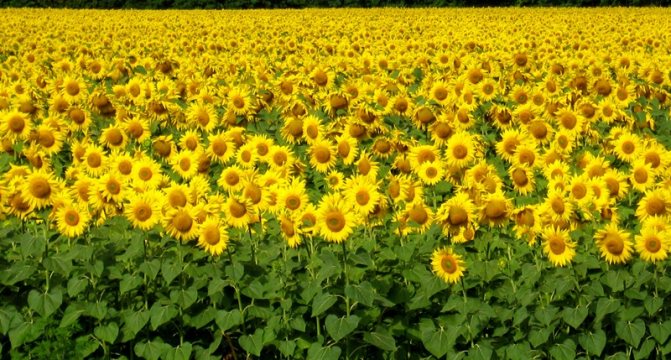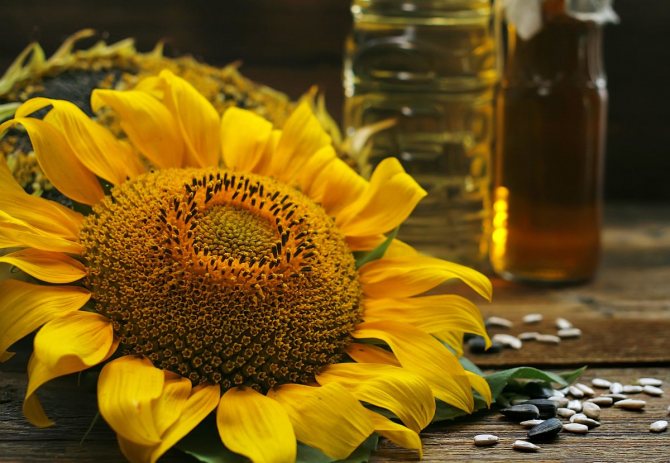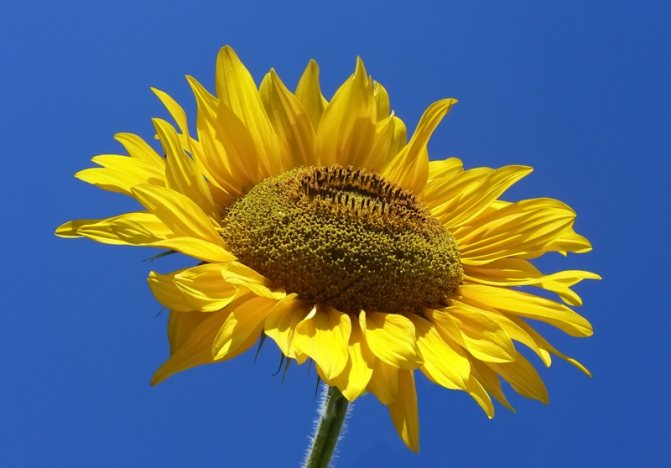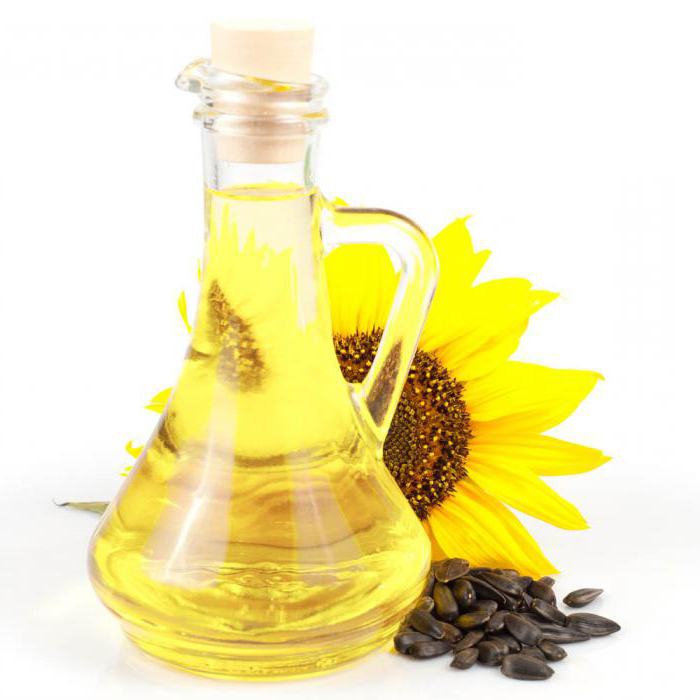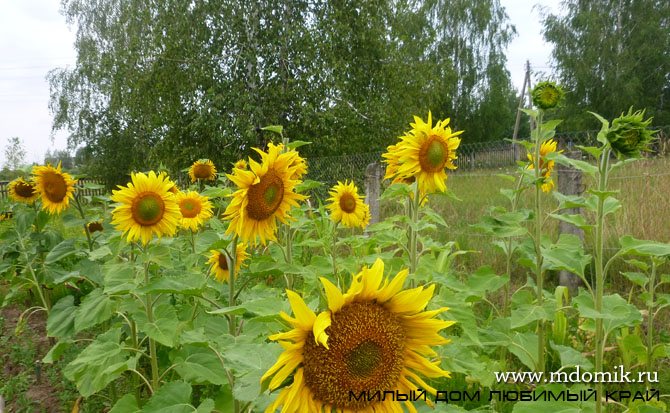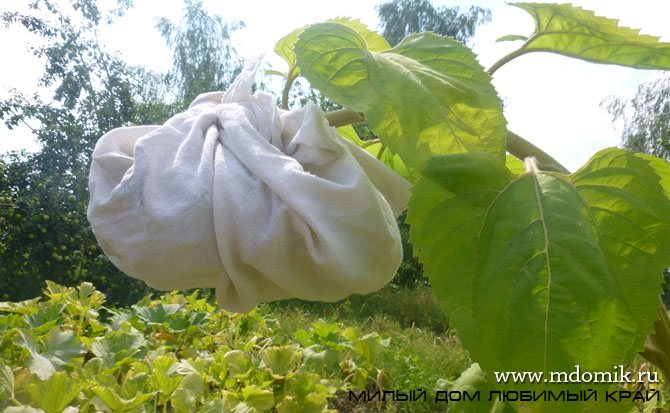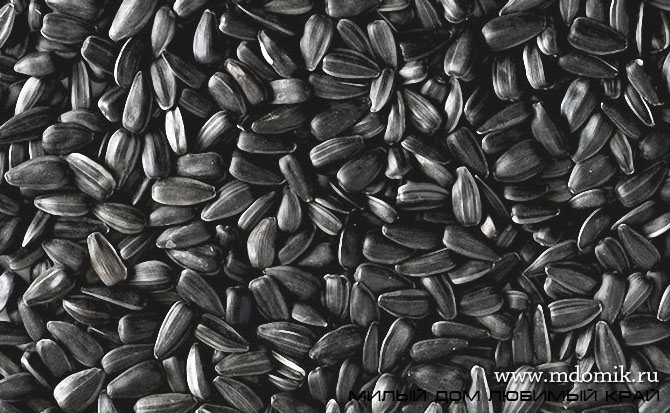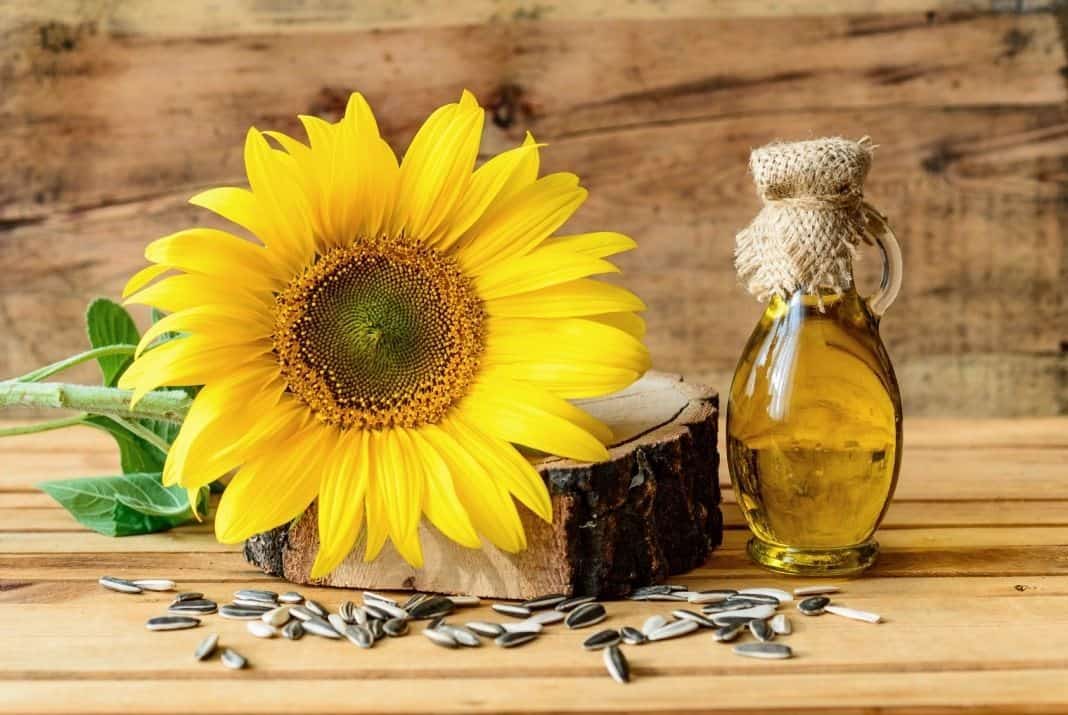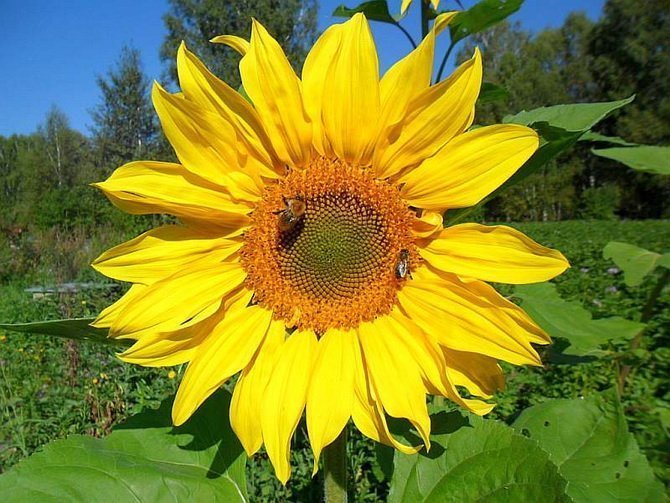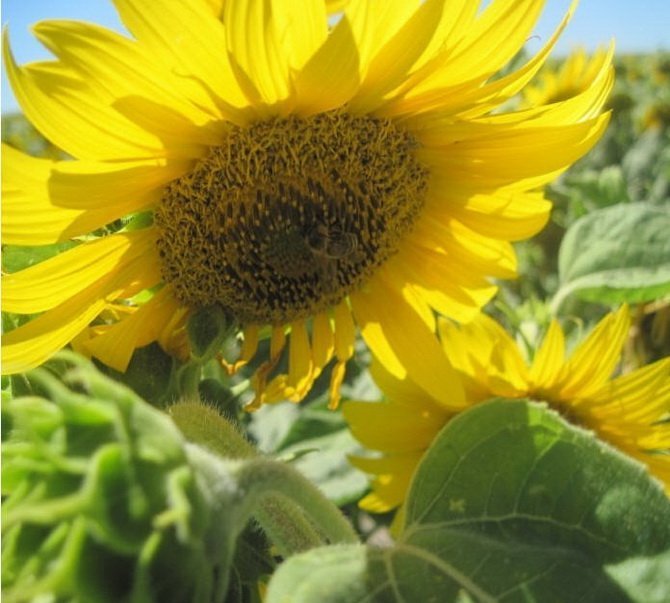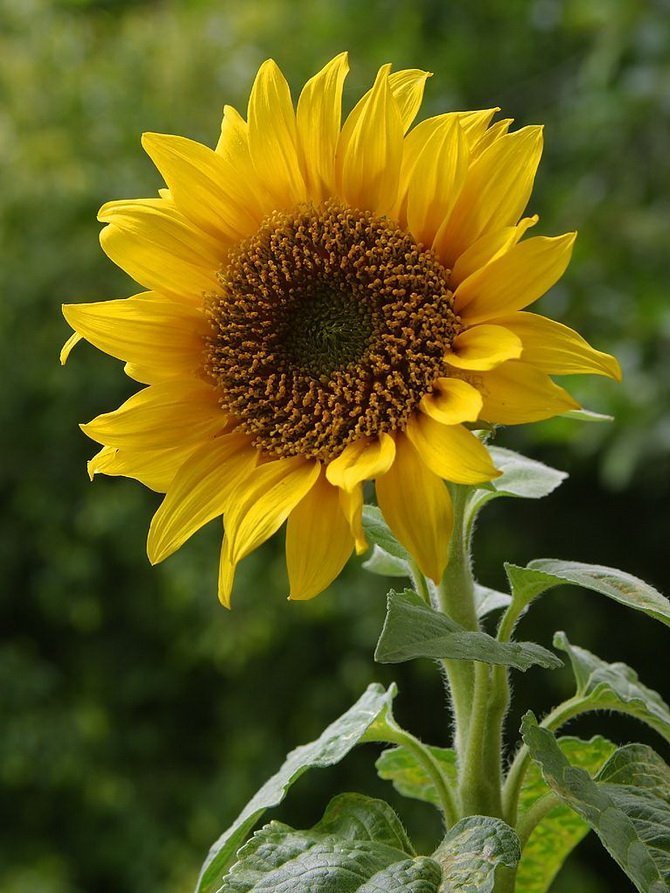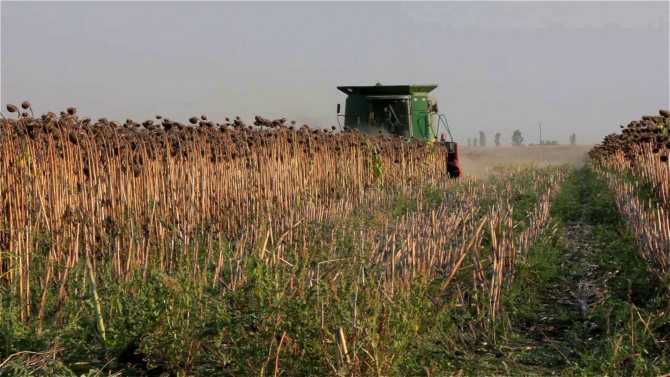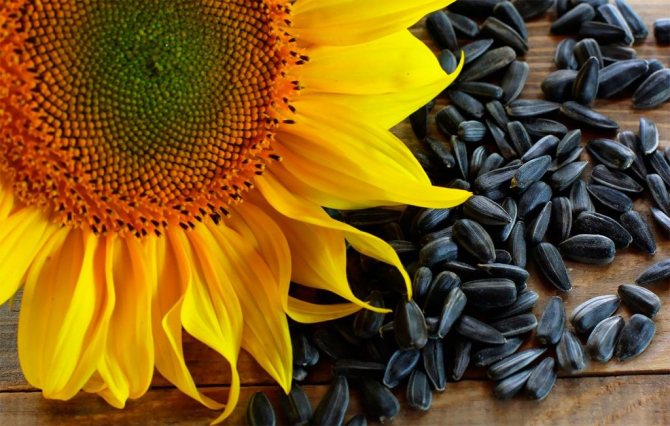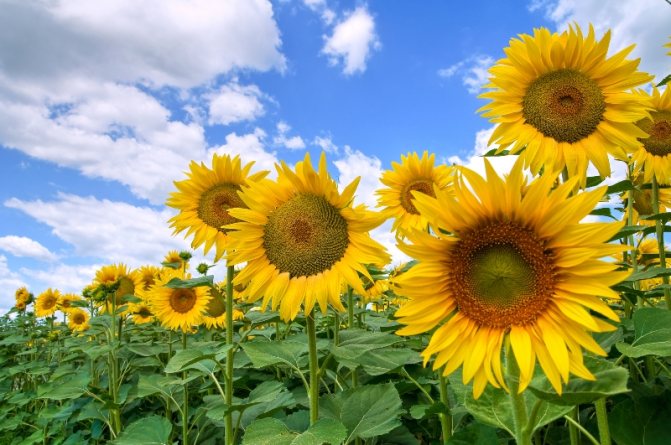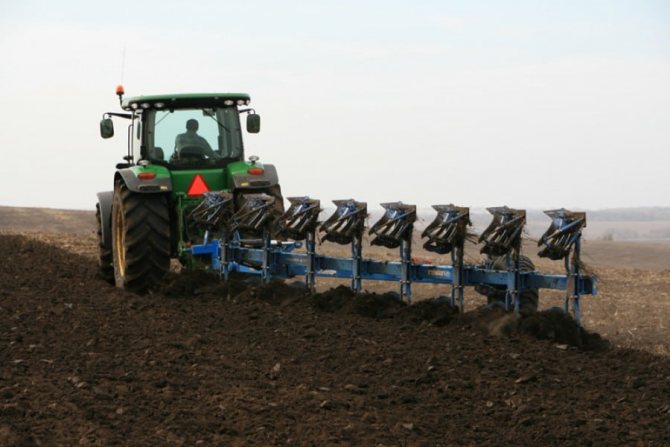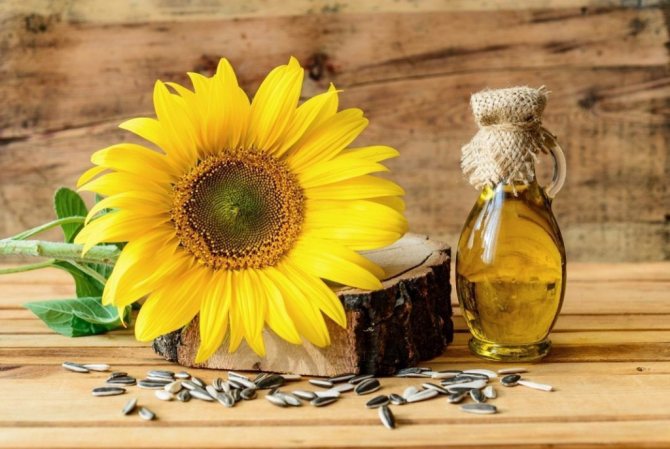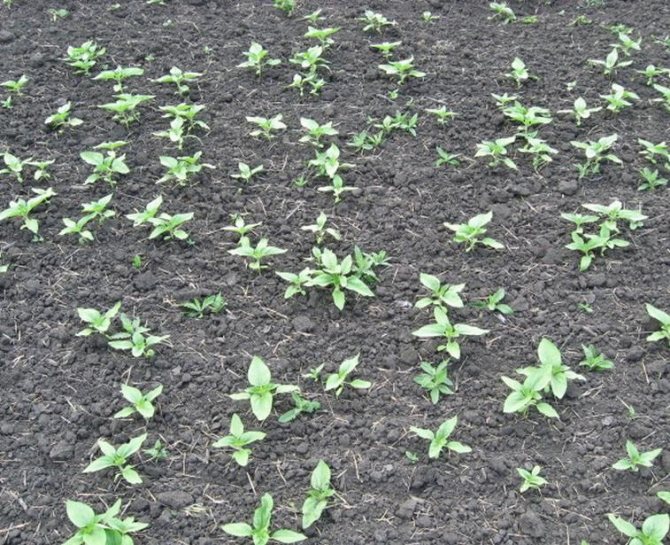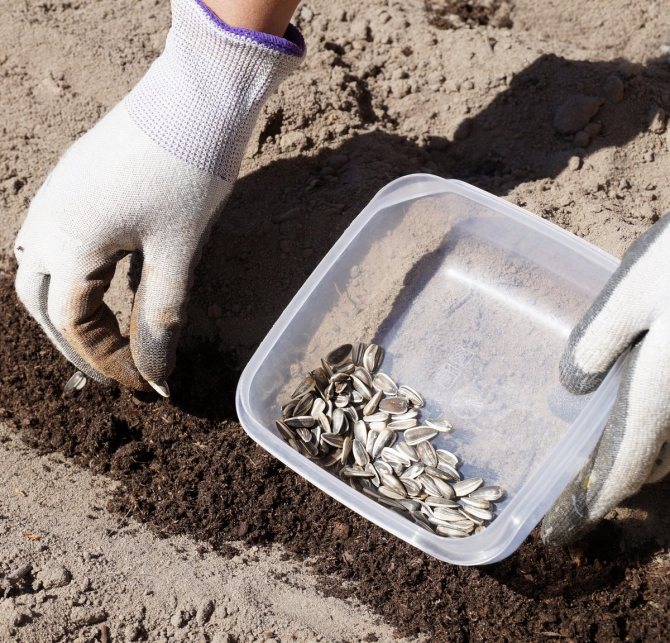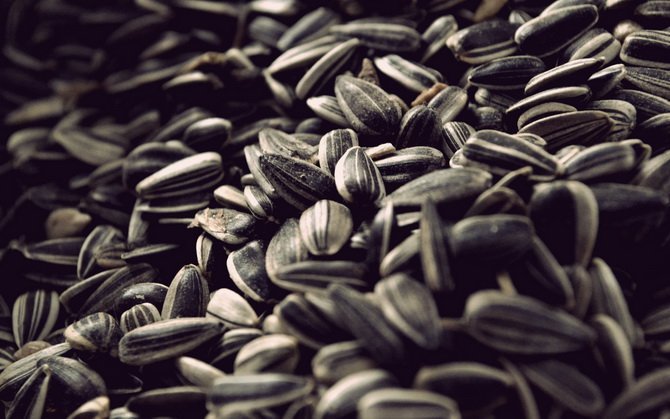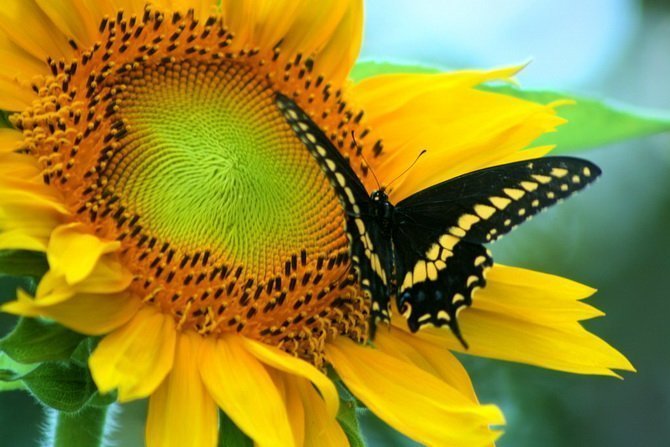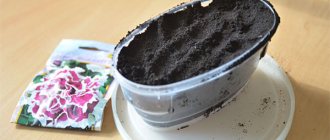The fields on which sunflowers grow are eye-catching, many people immediately want to take several pictures against the background of such amazing beauty. The inflorescence petals outwardly resemble the sun from a child's drawing. This miracle of nature amazes not only with its magnificent appearance, but also with its useful properties.
North America is considered the homeland of sunflower, and the production of sunflower oil began in England, in the second half of the eighteenth century. Since that time, breeders have bred many varieties of sunflower, which are highly resistant to various diseases and pests.
Description
Sunflowers are grown both on an industrial scale and in summer cottages. In addition to a good harvest, the plant gives the plot an additional flavor and can serve as a decorative function. The plant is unpretentious to care for and grows on almost any soil, which greatly simplifies the task of the gardener in growing a crop.
An annual plant can grow up to 3 m in height. On a tough, powerful stem, covered with small thorns, there are large dark green leaves. At the end of the trunk there is an inflorescence ranging in size from 15 to 45 cm in diameter. In the center of the receptacle there are numerous small flowers, and around the basket is decorated with a necklace of bright yellow petals.
Sunflowers tolerate drought and cold well, which is why they are grown almost all over the world. In addition, decorative varieties are used in landscape design to decorate flower beds and front gardens, and are also planted in pots as indoor plants.
This is curious
Annual sunflower is grown all over the world. But the sunflower is a truly Russian plant, it is recognized abroad as well. An integral part of rural landscapes are precisely these yellow flowers with black seeds located in the center.
The German amusement park Europa-Park (the largest in Germany and the second in Europe in terms of the number of visitors) has a Russian zone where sunflowers grow. And in Berlin, in one of its districts, the "Sunflower Maze" is arranged in the summer: a sunflower field with tangled paths. In Austria, there is a sunflower park with these plants, and of a wide variety of species and varieties.
Sunflower varieties
The sunflower familiar to everyone is represented by a wide variety of varieties, including hybrid ones, bred thanks to the successful work of breeders.
All sunflower varieties are divided into 4 groups:
- Oilseeds.
- Confectionery.
- Simple.
- Hybrid.
Hybrid varieties allow for 15% more harvest than conventional crop varieties. The seeds can be eaten fresh or processed into oil.
One of the popular sunflower hybrids is Bogdan. Representatives of this variety grow on poor soils and do not require additional fertilization. The variety is resistant to drought, cold weather, and also tolerates a large amount of precipitation. The height of the trunk varies from 150 to 180 cm, and the diameter of the basket averages 18 cm. The seeds are large, with a high oil content. The ripening period is 118 days.

Variety "Antey" is a medium-sized representative of hybrids, the height of which does not exceed 175 cm. The diameter of the basket varies from 20 to 23 cm, the period of seed ripening is 111 days.The plant is resistant to diseases and shedding. Large kernels contain more than 50% oil.
The high-yielding Yang variety is resistant to disease and drought. The height of the stem is 170 cm, and the diameter of the basket is 25 cm. The seeds are large, ripen in 104 days and contain more than 50% oil.
Confectionery varieties of sunflower are grown for consumption fresh and fried. The most common among them is the nutcracker. The crop is disease resistant and tolerates drought well. The kernels mature on average in 110 days. The oil content does not exceed 45%. The height of the stem reaches 2 m, and the diameter of the basket ranges from 18 to 25 cm.
The large-fruited variety "gourmet" up to 190 cm high has a convex basket with a diameter of 20 - 23 cm. The seeds contain up to 50% oil.
"Forward" is an oilseed hybrid variety with a ripening period of 105 days. The height of the stem does not exceed 185 cm, and the diameter of the basket averages 20 cm. The culture is resistant to diseases and pests. The kernels are striped and do not crumble when overripe.
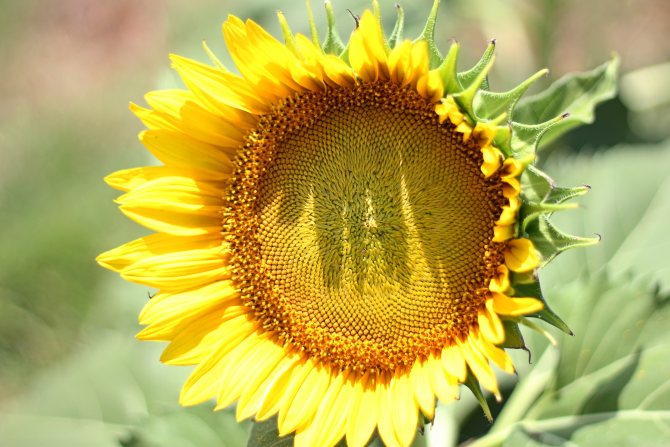

Ornamental sunflower varieties are widely used to decorate flower beds and flower beds, as well as for growing at home. Bright colors of flowers can decorate and revive the appearance of any area. Thanks to the work of breeders, various hybrids of decorative sunflower have been bred, including more than 150 species. On personal plots and city flower beds, you can find miniature and terry sunflowers of various colors.
Teddy variety refers to decorative sunflowers. The annual plant reaches 180 cm in height and is distinguished by a bright orange color of the basket. The culture is used for vertical design of flower beds and the creation of hedges.


A "ten-petal" sunflower does not exceed 1.5 m in height. The inflorescences of this culture can be simple and double, lemon or golden yellow in color. The flower is planted in a flower bed with other flowers, and hedges are also created, which look especially good against the background of lawns. The variety is perennial, grows over time, forming a large clump.
Storage
Regardless of the chosen methods of sunflower harvesting, after the combine, the seeds are delivered to the base for additional processing: they are freed from impurities and dried. Separators equipped with sieves are used here; their diameter usually varies in the range of 1-1.5 cm, and peas cleaners can also be used at this stage.
After cleaning, the crop is sent to elevators, where conditions for long-term storage are created, or for processing into oil.
Planting a decorative sunflower
Planting of a decorative sunflower is carried out in sunny, well-lit areas, protected from the wind. The soil should be loose, well-drained, enriched with nutrients necessary for the growth of cultivated plants. If the soil is not fertilized before planting, the sunflower will draw out all the nutrients from it, and next year it will be possible to sow only green manure in this area in order to restore the supply of nutrients in the soil.
Sowing seeds
Seeds of decorative varieties are pre-soaked in a damp cloth or gauze. To enrich the seed with minerals, a solution is prepared from wood ash, in which the seeds are kept for 4 - 6 hours. To obtain a nutrient mixture, mix 2 tablespoons of ash and 1 liter of water. The resulting liquid is insisted for 2 days in a dark place.
Sowing in open ground is carried out in early May, when the soil has warmed up well and the threat of frost has passed. The seed is buried in the ground no more than 2 - 3 cm. The distance between the seeds should be 30 - 70 cm. Planting is carried out in moist soil, the seeds are covered with earth on top. It is not recommended to compact the soil in order to provide a normal access of oxygen to the seeds.
It is necessary to plant only sprouted seeds. Dry seed may not hatch in the soil.
Watering the seedlings is carried out regularly as the soil dries out. Prolonged drought can lead to the death of seeds, therefore, before the emergence of seedlings, you should constantly monitor the moisture content of the soil in the area. Crops do not need abundant watering, since a large amount of water can lead to rotting of seeds.
Follow-up care
Decorative varieties of sunflowers do not require special attention. All that flowers need is regular, timely watering and the absence of stagnant water in the soil. For better passage of moisture and air to the root system, the soil in the area with sunflowers is regularly loosened so that a crust does not form.
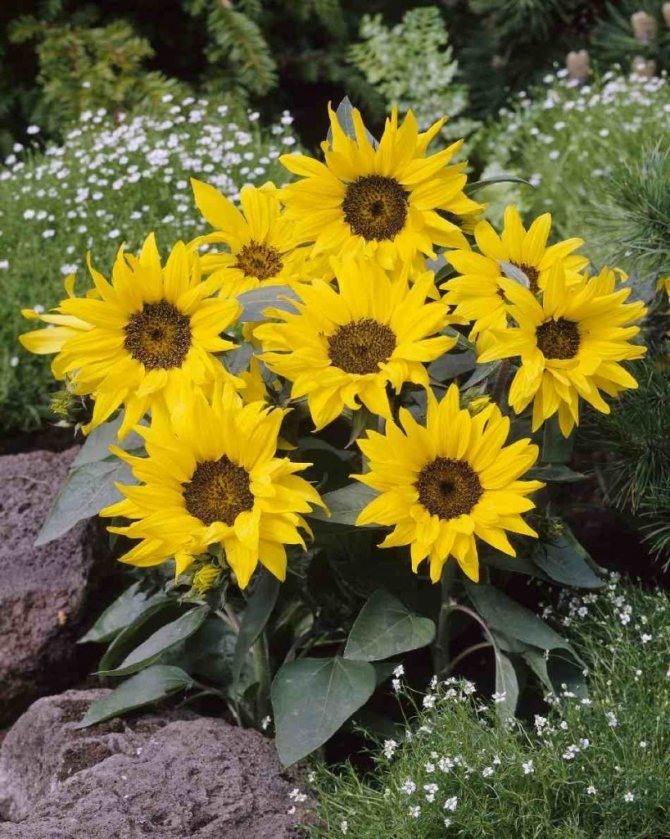

Sunflowers do not need feeding, especially if they grow on fertile soils. It is possible to apply mineral and organic fertilizers if neighboring plants are fed.
In areas with decorative varieties of sunflowers, it is necessary to regularly remove weeds. In dense thickets of weeds, pests can appear that affect the culture.
Care
We recommend planting sunflowers in several passes at weekly intervals. This will allow you to increase your yield and get ready-made seed baskets from July until the first frost. If you are planting sunflowers in flower beds or flower beds (elongated narrow flower beds), then observe the following rule: closer to the sunny side there should be less tall varieties, and higher ones can be planted on the far side. This will allow all plants to receive enough sunlight and warmth, which is the key to successful cultivation of this crop. Also keep in mind that as they mature, the flowers stop turning to follow the sun and remain turned towards the rising sun.


Sunflower on the site
Watch out for the fading baskets - they need to be cut off. This will make room for new flowers on that stem and also give more light to the remaining sunflowers. If the sunflower has completely faded, then cut it off. Be careful, as tall plants have developed roots and if you decide to pull out the plant, you can damage the root system of the neighbors.
We recommend growing many different varieties of sunflowers with different parameters (color, height, shape).
If the plants are planted in an open space, then a garter is needed. Perennial plants are recommended to be insulated for the winter. Branches or even stems from annual sunflowers are perfect for these purposes.
You can use sunflowers as a hedge. To do this, undersized varieties are planted in front, and high ones in the back. Small plants will cover the stems of tall ones and will not block the inflorescences from the sun.


Sunflower hedge
In the EU countries, sunflower is also used as a cutting plant. They can be found not only in specialized stores, but also at street vendors. The sun flower has come to the taste of everyone - both ordinary residents and art workers, who make exquisite bouquets of them. Take a look at the photo of sunflower flowers.
A feature of ornamental plants is the absence of crumbling pollen, which could stain hands and clothes. Breeders from Japan should be thanked for such an invention.
The sunflower is quite popular in North America, where it actually comes from. All kinds of exhibitions are held there, where you can see the latest achievements of botanists. International sunflower breeding companies also exhibit at the exhibitions.
Planting sunflowers in pots
Sunflowers can be grown at home by the window just like other houseplants. At first glance, this task seems impossible due to the high growth of culture.But there are many decorative varieties that allow you to plant a sunflower in pots.
Choice of capacity
The planting container, which will be used for planting the sunflower, is chosen depending on the size of the adult plant. It is not recommended to plant sunflowers in pots with a small radius; for dwarf varieties, containers with a diameter of 35 - 40 cm are suitable, respectively, for larger varieties, you need to choose a larger size. For sowing seeds for seedlings, you can use boxes. Planting of giant varieties is carried out in containers with a volume of 15 - 18 liters.
The material from which the landing container is made can be anything. Most often, the plant is planted in plastic flower pots. There should be drainage holes at the bottom of the container to drain excess moisture during watering.
The container must be disinfected before planting. To do this, an empty pot is treated with boiling water before placing the soil in it.
Soil selection
Normal growth and development of the plant ensures the correct choice of soil. For planting ornamental sunflower varieties, loose, well-drained soil with a supply of essential nutrients is needed.
You can buy ready-made potting soil at a flower shop. This soil has already been enriched with the necessary mineral and organic components, as well as disinfected.
For self-preparation of the mixture, you will need garden soil, peat and compost, taken in equal proportions. Before planting, the soil is disinfected in an oven at a temperature of + 150 ... + 200 degrees or plentifully spilled with boiling water.
At the bottom of the planting container, a drainage layer of perlite, expanded clay or pebbles with a thickness of 2 - 3 cm is laid out.Then the container is filled with prepared soil mixture, leaving 2.5 - 3 cm from the edge.
Before sowing, the soil is watered and the seeds are buried by 2.5 - 3 cm. Two seeds are placed in a pot intended for planting one seedling, since one may not germinate. If sowing is carried out in large boxes, you can arrange the seed in pairs at a distance of 5 - 7 cm from each other. After the seedlings have grown and grown strong, they are transplanted into separate pots.
Seedlings require regular, frequent watering. It is necessary to constantly maintain the moisture of the soil, but not to allow it to block.
Seeds germinate in 5 to 8 days. If seedlings do not appear after two weeks, then the seeds have died.
Care rules
Before the plant reaches 30 cm in height, you need to constantly keep the soil moist with regular watering. The container with seedlings should be placed in a well-lit place so that the sunflower has access to sunlight throughout the day. In an apartment, it is undesirable to place a pot on a windowsill, since the air temperature near the windows differs from room temperature. You can take out the seedlings to the balcony or loggia during the warm season.
Sunflowers generally do not need feeding. They have enough nutrients contained in the soil. Fertilizers are applied in order to prolong flowering and strengthen the vitality of the plant during the period of bud formation.
Blooming underflowers are tied to a support as needed so that the plant does not lean under the weight of the basket. To do this, you need to dig a bamboo stick or a peg into the pot in order to raise the flower head up.


Indoor sunflower does not require special attention. Beautiful flowers will become a decorative element of the interior, and regular watering of the plant will allow you to enjoy flowering for a long time.
How is the crop harvested?
In order to fully appreciate the healing properties of a plant, it is necessary not only to grow it correctly, but also to correctly harvest the ripe crop. Approximately 35-40 days after flowering has ended and the last petals of the sunflower have fallen off, the process of accumulation of oils ends.The moisture from the achenes evaporates, and a waxy ripeness is achieved. After the baskets have turned to the east and froze in this position, you can start harvesting. By this time, the leaves of medicinal plants dry up and acquire a dark brown hue. The stem also darkens.
Chinese cabbage bok choi: description and useful properties
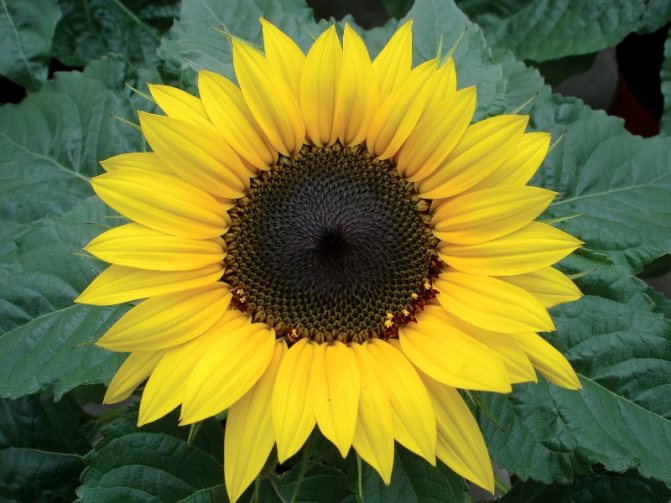

In order to fully appreciate the healing properties of a plant, it is necessary not only to grow it correctly, but also to correctly harvest the ripe crop.
In sunny and dry weather, the baskets are left on the stems to dry out. If it rains, the achenes are carefully cut and put to dry in a place that is reliably protected from moisture. After the seeds are completely dry, they are gently shaken off into a bucket. In the future, the harvest is packed in paper or fabric bags. Store seeds in a dry place. Some experts recommend pre-washing them to remove dirt.
Planting in the garden
Planting a sunflower in the garden does not require much effort from a summer resident. The culture is unpretentious in care, it tolerates drought and small soil frosts (up to -5 degrees) well. To get a good harvest of seeds, you need to follow the simple rules of planting and subsequent care of the plant.
The sunflower is planted in areas well-lit by the sun, protected from the constant influence of the wind. The plant is undemanding to the soil, but for good growth it is better to plant the crop on fertile, slightly acidic soils. It is not recommended to plant in areas where legumes, beets and tomatoes were previously grown. After them, the soil is abundantly saturated with nitrogen, which sunflowers do not like very much. The place in the garden should be changed annually so that the soil can recover.
Seed preparation and planting
Before sowing, the seeds are soaked and treated with special preparations that can be purchased at a flower shop, or with an infusion of garlic with onion peels. To prepare you need to take:
- 100 g crushed garlic;
- 20 - 30 g of onion husks;
- 2 liters of boiling water.
The mixture is infused for 24 hours, filtered through cheesecloth and the seeds are soaked in it 10 - 12 hours before planting. This treatment scares away rodents and insects that destroy seeds in the soil.


Sowing is carried out when the soil has warmed up to a temperature of + 10 ... + 12 degrees, at the end of April - at the beginning of May. The seeds are planted in holes or grooves, which are pre-moistened, to a depth of 5 - 8 cm. 2 - 3 seeds are placed in each planting hole. The distance between tall plants should be at least 70 cm; for low-growing varieties, a distance of 50 cm is observed.
How to care?
Even unpretentious crops need high-quality care in order to get a good harvest later. The sunflower needs abundant and regular watering, especially during dry periods. It is especially important to irrigate the area before germination so that the seeds have enough moisture to germinate. The frequency of watering depends on the drying out of the soil. In severe drought, several irrigations per day may be required. You need to introduce water at the root so as not to wet the leaves. It is advisable to carry out the procedure early in the morning or in the evening.
The garter of sunflowers is carried out so that the plant does not break under the weight of the basket. Tall varieties can bend low to the ground, causing stem breakage and death of the seedling. If the culture is planted in a place protected from the wind, tying can be omitted.
Sunflower grows well without additional feeding. If the soil is oversaturated with nitrogen, the crop can be exposed to disease and pest attacks. For normal plant growth, you can fertilize the soil with potassium and potassium-phosphorus fertilizers. After carrying out such dressings, the bees pollinate the plants better, and the seeds are formed full and large.
The first top dressing is carried out during sowing, and the subsequent ones - after watering in wet soil.It is recommended to apply fertilizers together with water, as they are better absorbed than granules.
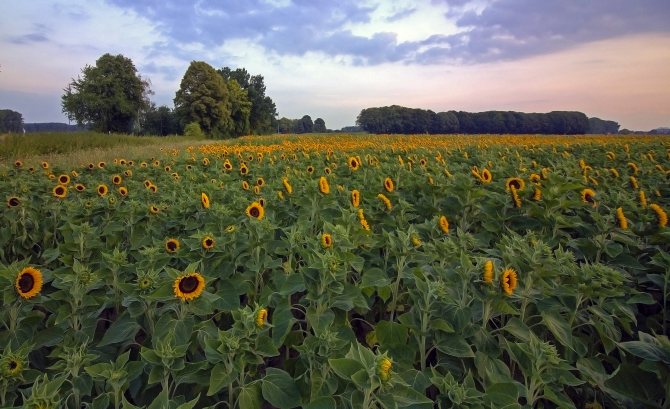

In an area with sunflowers, it is necessary to regularly remove weeds and loosen the soil so that moisture and oxygen better flow to the roots.
Sunflower herbicides - what are they for and what are they
There are many varieties of herbicides and they greatly help to simplify the care of sunflower, especially in the initial stages. There are several groups of herbicides, we will consider them in more detail.
- Continuous action. Absolutely all monocotyledonous and dicotyledonous plants are killed, including perennial grasses, bushes and other weeds that grow on the site. Processing is carried out 1 year before sowing or 3-4 weeks before planting seeds in the ground, only the dose is reduced. Thus, all plants growing at the time of processing are destroyed, the soil is sterilized. Such drugs include "Hurricane-32", "Sword" and others. The dose and application are described in detail in the instructions for the drug, but about 90 grams per hectare.
- Complex. They kill all plants growing with the sunflower without harming it. They are applied only to some types of sunflowers, mainly French and American selection (Lessa, Pioner 323, Filler). You cannot spray ordinary sunflower - it has no immunity. Processing costs 1,300 rubles per hectare, so it is not suitable for every farmer.
- Against monocots. It kills all known monocots, leaving the sunflower and other dicotyledons, which, as a rule, are very few. A particularly effective method for combating wild millet. Very often, such herbicides are also mixed with foliar dressings, so you can kill weeds in one go, as well as feed the crop.
It is worth processing a sunflower only in the early stages, since with a plant height of 50 centimeters and above, such processing will not give anything - the leaves will completely cover the ground and all weeds that have not previously grown above 20-30 centimeters will stop growing or dry out over time. Growing a sunflower should be carried out in an open area, where the sun's rays fall throughout the day. If planted in the shade, the stem will be very thin, the leaves will begin to turn yellow, chlorophyll is not released, and the seeds will be very "thin" and half-empty.
Pests
- Snails... They are very dangerous, they can damage both seedlings and adult plants. If there are a lot of snails, then you can purchase poisonous pellets, or collect them by hand.
- Spider mites... Mites attack plants that grow at home. If this has already happened, then it is necessary to increase the moisture content of the soil and spray the plant with water. It is recommended to destroy the diseased plant so that the pests do not infect healthy specimens.
- Caterpillars... These pests are quite gluttonous and cause great harm to plants. It is best to collect them by hand.
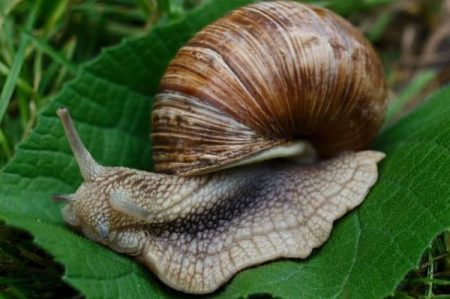

Snail


Caterpillar
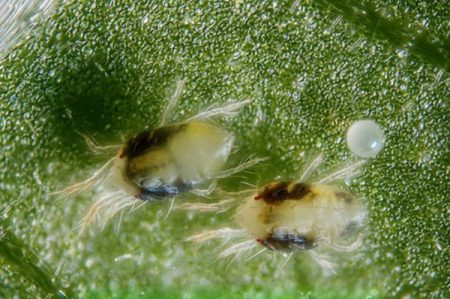

Spider mite
Growing conditions
The minimum temperature for seed germination is 5 ° C, the soil must be warmed up to at least 8 ° C. Sowing is recommended no earlier than the second half of May; in the southern regions, planting is possible starting from mid-April. A slight cold snap during the budding period directly affects the yield.
It is not recommended to grow sunflower in regions with frequent spring frosts. Shady areas with regular exposure to wind are not suitable for growing sunflowers. With a lack of light, the seeds form small and dense. The place should be sunny and protected from strong gusts of wind.
Soil requirements
For planting, it is advisable to select a place with fertile and arable soil. It should be lightweight and breathable. Sowing in muddy areas, as well as lowlands and near water bodies is not recommended. The highest productivity is observed on sandy loams and loess soils. The acidity index should be in the range of 6-7 pH.




